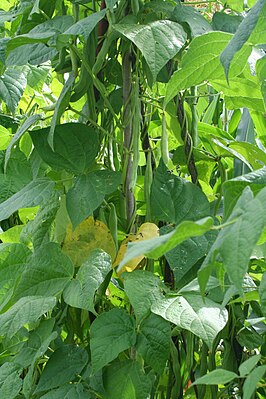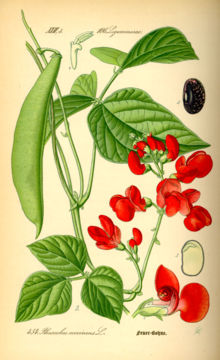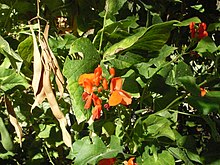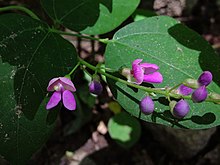Phaseolus
| Phaseolus | ||||||||||||
|---|---|---|---|---|---|---|---|---|---|---|---|---|

Cultivated form of the common bean ( Phaseolus vulgaris ) |
||||||||||||
| Systematics | ||||||||||||
|
||||||||||||
| Scientific name | ||||||||||||
| Phaseolus | ||||||||||||
| L. |
The species of the genus Phaseolus are called New World beans . Like the ancient Vigna bean genus, they are assigned to the subfamily of the butterflies (Faboideae) within the legume family (Fabaceae).
description







Vegetative characteristics
Phaseolus species grow as creeping or climbing, more rarely independently upright, annual or perennial herbaceous plants , or rarely as subshrubs . They are not armed with spikes or thorns. The climbing species are left-hand winding , so (when viewed from above) they wind up counter-clockwise.
Arranged alternate and helically distributed on the stem leaves are divided into petiole and leaf blade. The leaf blade is usually pinnate unpaired. There are usually three, rarely only one, pinna flake present, the leaves are therefore usually three parts. The flat leaflets are entire. There are two persistent stipules .
Generative characteristics
The flowers are grouped in bundles in lateral, compound racemose inflorescences . There are bracts and cover sheets available.
The hermaphrodite flowers are zygomorphic and five-fold with a double flower envelope . The five unequal sepals are fused with two sepal lips. The upper calyx lip consists of two calyx lobes, the lower one consists of three calyx lobes. The flower crowns have the typical structure of the butterfly flowers . There are five nailed petals , two of which have grown together to form a boat and the others are free. The round flag is not spurred but eyed and has two differently pronounced appendages depending on the species. The shuttle often follows the screwing of the ovary: the narrow shuttle forms a screw with one to five complete turns. There are ten fertile stamens . Nine stamens have grown together to form a tube. The individual upper carpels contain three to many ovules . The stylus, which is curved up to 360 °, can be partially hairy.
There are legumes formed. Each fruit contains three to many seeds. The seeds are usually kidney-shaped or elongated. Distribution unit ( diaspore ) is the seed.
Photoperiodism
Most Phaseolus species are short-day plants or are day-neutral, depending on their home area. Only Phaseolus coccineus and Phaseolus polystachus have long-day varieties.
use
Some species are cultivated for the production of food:
- Lima bean , moon bean ( Phaseolus lunatus L. )
- Tepary bean ( Phaseolus acutifolius A. Gray )
- Fire bean , make-up bean ( Phaseolus coccineus L. )
- Common bean ( Phaseolus vulgaris L. ): There are a variety of forms: bush beans , pole bean , kidney bean = kidney bean, pearl bean , Wachtelbohne = Pinto Bean , Black Bean , Kidney Bean.
Since they fix nitrogen ( Rhizobium root nodules ), they are important for soil improvement.
Occurrence
The distribution area originally only includes the New World between 37 ° N and 30 ° S.
Systematics
Today only 50 to 71 species are counted to the genus Phaseolus ; earlier, around 150 to 200 species were classified in this genus. Only the New World species belong to Phaseolus - the Old World species are mainly classified in the genus Vigna . The genus Phaseolus belongs to the subtribe Phaseolinae of the tribe Phaseoleae in the subfamily Butterflies (Faboideae) within the legume family (Fabaceae). The genus Phaseolus was published in 1753 by Carl von Linné in Species Plantarum , 723. Synonyms for Phaseolus L. are: Phasellus Medik. , Phaseolos St.Lag. , Caracalla's death. , Lipusa Aleph. , Candelium med. , Cadelium Medik. , Alepidocalyx Piper , Minkelersia M.Martens & Galeotti , Rudua F.Maek.
The genus Phaseolus is named after G. Lewis, et al., Eds .: Legumes of the world. (Leg World), 2005, 428 divided into 15 sections, here listed with all types:
- Section Acutifolii : With only two species:
- Tepary bean ( Phaseolus acutifolius A. Gray ): With about two varieties.
- Phaseolus parvifolius Freytag
- Section Bracteati : With only two types:
- Phaseolus macrolepis Piper
- Phaseolus talamancensis Debouck & Torres González
- Section Brevilegumeni : With only three species:
- Phaseolus campanulatus Freytag & Debouck
- Phaseolus oligospermus Piper
- Phaseolus tuerckheimii Donn.Sm.
- Section Chiapasana : With the only kind:
- Phaseolus chiapasanus Piper
- Section Coccinei : With the only species:
- Fir bean , beetle bean or runner bean ( Phaseolus coccineus L. ): With many varieties.
- Section Coriacei : With only three species:
- Phaseolus maculatus Scheele : With two subspecies.
- Phaseolus reticulatus Freytag & Debouck
- Phaseolus venosus Piper
- Digitati Section : With five types:
- Phaseolus albiflorus Freytag & Debouck
- Phaseolus albiviolaceus Freytag & Debouck
- Phaseolus altimontanus Freytag & Debouck
- Phaseolus neglectus F.J. Herm.
- Phaseolus trifidus Freytag
- Section Falcati : With five species:
- Phaseolus leptostachyus Benth. : With four varieties.
- Phaseolus macvaughii A Delgado
- Phaseolus micranthus Hook. & Arn.
- Phaseolus opacus Piper
- Phaseolus persistentus Freytag & Debouck
- Section Minkelersia : With about ten species:
- Phaseolus amabilis Standl.
- Phaseolus amblyosepalus (Piper) CVMorton
- Phaseolus anisophyllus (Piper) Freytag & Debouck
- Phaseolus nelsonii Maréchal et al.
- Phaseolus parvulus Greene
- Phaseolus pauciflorus Sessé & Moc. ex G.Don
- Phaseolus perplexus A Delgado
- Phaseolus plagiocylix Harms
- Phaseolus pluriflorus Maréchal et al.
- Phaseolus tenellus Piper
- Paniculati section : With around 16 species:
- Phaseolus acinaciformis Freytag & Debouck
- Phaseolus albinervus Freytag & Debouck
- Phaseolus dasycarpus Freytag & Debouck
- Phaseolus jaliscanus Piper
- Phaseolus juquilensis A.Delgado
- Phaseolus longiplacentifer Freytag
- Lima bean , Indian moon bean, or moon bean ( Phaseolus lunatus L. )
- Phaseolus maculatifolius Freytag & Debouck
- Phaseolus marechalii A.Delgado
- Phaseolus nodosus Freytag & Debouck
- Phaseolus polystachios (L.) Britton et al. : With about four subspecies.
- Phaseolus rotundatus Freytag & Debouck
- Phaseolus salicifolius Piper
- Phaseolus scrobiculatifolius Freytag
- Phaseolus sonorensis Standl.
- Phaseolus xolocotzii A. Delgado
- Pedicellati section : With about ten species:
- Phaseolus esperanzae Seaton
- Phaseolus grayanus Wooton & Standl.
- Phaseolus laxiflorus Piper
- Phaseolus oaxacanus Rose
- Phaseolus pedicellatus Benth.
- Phaseolus polymorphus S. Watson : With two varieties.
- Phaseolus purpusii Brandegee
- Phaseolus pyramidalis Freytag
- Phaseolus scabrellus Benth. ex S. Watson
- Phaseolus teulensis Freytag
- Phaseolus Section : With four types:
- Phaseolus albescens McVaugh ex R. Ramirez & A Delgado
- Phaseolus costaricensis Freytag & Debouck
- Phaseolus dumosus Macfad.
- Garden bean ( Phaseolus vulgaris L. ): With two varieties.
- Section Revoluti : With the only kind:
- Phaseolus leptophyllus G.Don
- Section Rugosi : With only two types:
- Phaseolus angustissimus A. Gray
- Phaseolus filiformis Benth.
- Section Xanthotricha : With about six species:
- Phaseolus esquincensis Freytag
- Phaseolus gladiolatus Freytag & Debouck
- Phaseolus hintonii A Delgado
- Phaseolus magnilobatus Freytag & Debouck
- Phaseolus xanthotrichus Piper
- Phaseolus zimapanensis A.Delgado
See also
swell
- SI Ali: Papilionaceae in the Flora of Pakistan : Phaseolus - Online.
- Walter H. Schuster: Legumes for grain use : Information on the genus Phaseolus . (German).
Individual evidence
- ↑ a b Phaseolus in the Germplasm Resources Information Network (GRIN), USDA , ARS , National Genetic Resources Program. National Germplasm Resources Laboratory, Beltsville, Maryland.
Web links
- Phaseolus in the Germplasm Resources Information Network (GRIN), USDA , ARS , National Genetic Resources Program. National Germplasm Resources Laboratory, Beltsville, Maryland.
- Names in the genus Phaseolus .
- phaseolus.net .
